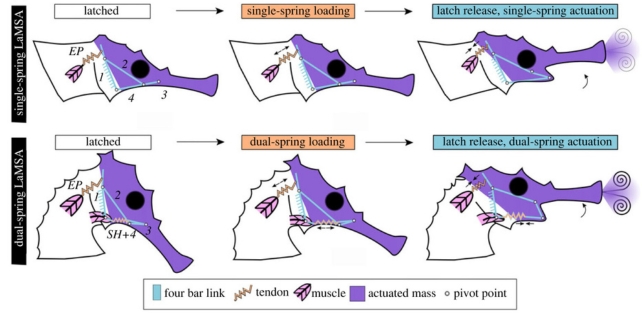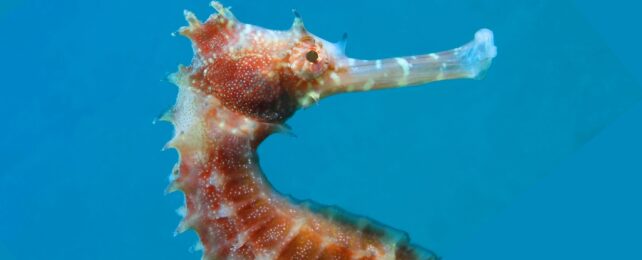We already know seahorses are among the cutest and most unique critters in the ocean, and now scientists have found out more about a clever and unusual way that they eat.
Researchers from Tel Aviv University in Israel and the Rochester Institute of Technology in the US have calculated the power required of specialized anatomy the weirdly-snouted fish use to draw in a mouthful of prey.
Seahorses use two spring-like tendons to quickly suck in water and tilt their heads to capture prey all in one swift motion. The powerful 'gulp' enables the animals to take in water at a rate about eight times greater than they could with muscular effort alone.
"[T]wo masses are accelerated simultaneously by the same system (i.e., the head as it swings upwards and the water sucked into the mouth)," the researchers explain in their published paper.
So even though they're small and slow, seahorses can speedily gulp down their food and drink (useful as they feed often), leaving more time for other seahorse activities.
Seahorses (Hippocampus sp.) are members of the fused jaw fish family Syngnathidae, which also includes cool characters like leafy sea dragons (Phycodurus) and pipefishes (Phyllopteryx). Syngnathids catch prey by rotating their long snouts upward, using an elastic tendon connecting a muscle in their neck to the rear of their skull.
Research has shown that some animals, like fleas and trap-jaw ants, are super swift at jumping or catching prey because they evolved a special mechanism called the latch-mediated spring-actuated (LaMSA) system.
The LaMSA system uses strong muscles to stretch an elastic part, which is then locked in place until it's time to release it all at once. This sudden release gives the animal a lot of power to make extra-quick movements. Although LaMSA is mostly found in insects and other animals without backbones, some fish have evolved a similar system.
Seahorses have a four-bar linkage system that helps transmit power to their heads. Unlike other LaMSA systems, one of the bars in the seahorse's system is not rigid. Instead, it's made up of a bone and a tendon-muscle complex that according to previous research may store elastic energy.
Scientists knew that seahorses are efficient at catching elusive prey because they generate suction flows that are much faster than those of other fish. These flows have to be produced during the head rotation to prevent prey from escaping, and the research team predicted that the elastic energy stored in the seahorse's LaMSA system may be involved.
But it was unclear how this mechanism allowed suction flow and head elevation to occur simultaneously.
Zoologist Roi Holzman from Tel Aviv University in Israel and colleagues in the US looked into this mystery by shining a light through a seahorse's semi-translucent skin as it fed, and they spotted a second tendon below the chin that could give the jaw extra power.
"We were able to actually see that the tendon contracts, which means that it can store elastic energy," Holzman told New Scientist's Corryn Wetzel.
"This is cool because up until now, we didn't really know of any elastic energy storage mechanism that serves two purposes".

This means the seahorse's LaMSA system is powered by two tendons, which work together to speed up the head rotation and increase the suction of fluid in front of the mouth.
Holzman and team then visualized the water flow and used hydrodynamic modeling to determine the net power required to accelerate the suction-feeding flows of 13 different fish species.
The power of a seahorse's suction feeding is roughly three times that of any vertebrate muscle, resulting in suction flows roughly eight times faster than similarly sized fishes.

Further testing also revealed that the tendons, both of which are elastic, rapidly contract to release about 72 percent of the power required to speed up the entry of water into the mouth.
These results give scientists new information about the size, function, and design of LaMSA systems, and they show how seahorses have developed adaptations to help them eat more efficiently.
"I'm sure that they have some other crazy innovations that we haven't found," Holzman told New Scientist.
The study has been published in Proceedings of the Royal Society B.
